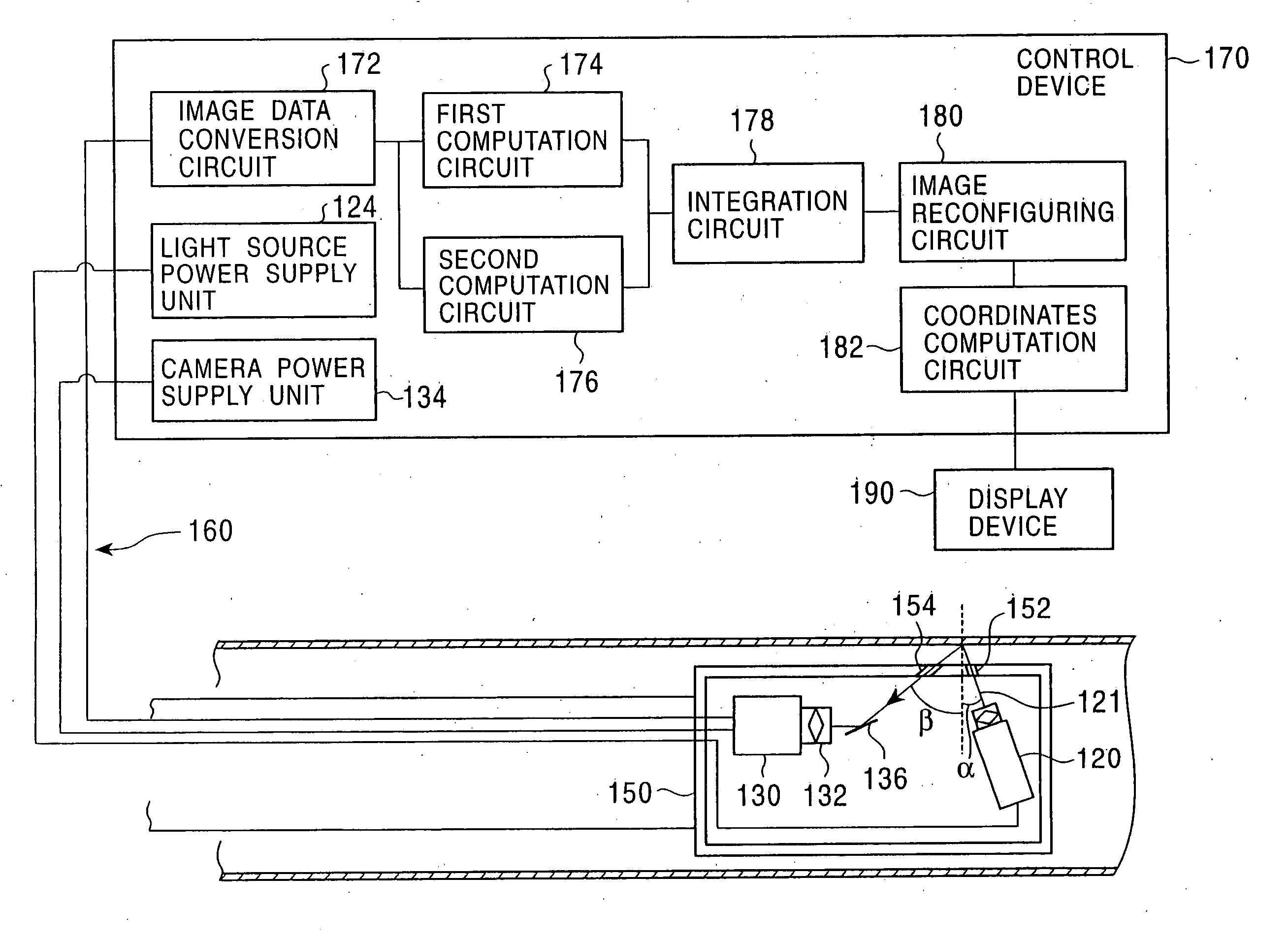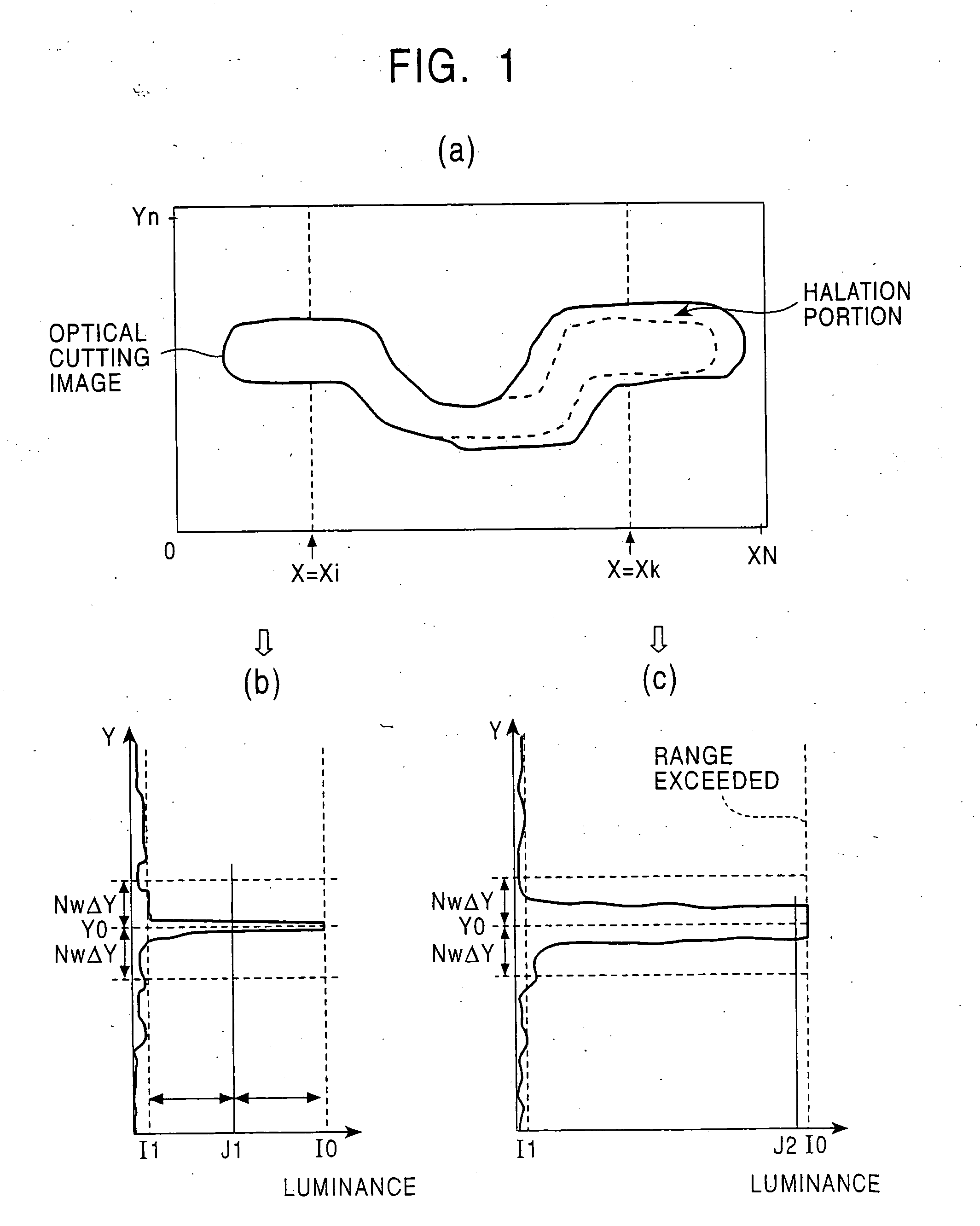However, there have been cases wherein, while manufacturing a number of electric resistance welded pipes, the position of the
cutting tool shifts due to a variety of reasons, the blade of the
cutting tool is nicked, etc., causing defective cutting such as not all of the bead being
cut off of the electric resistance welded pipe product or cutting too deep.
Such cutting defects not only mar the look of the electric resistance welded pipe product; using electric resistance welded pipes with cutting defects for
piping subjected to pressure such as gas lines or the like may place the pipe at risk of rupturing.
Even with regard to the outer face of the pipe which is readily observed from the outside, monitoring of the bead cutting shape has to depend on
visual observation of workers, so precision and reproducibility thereof is insufficient, and there have been quantitative and reliability problems.
With regard to the inner face of the pipe, the bead cutting portion cannot be directly observed during manufacturing, due to the configuration of the
production line.
With the former method, the observation position is several tens of meters downstream from the cutting position, so there has been a problem in that in the event that an
abnormality occurs in the cutting, the defective pipe becomes longer until detected, resulting in decrease in yield.
Also, with the later method, the cutting tool seizes due to friction heat in the event that the line is stopped, so the cutting tool must be retracted.
Resetting the cutting tool and restarting the line creates a step between the previously-cut bead cutting shape and the new cutting shape, so that portion is unusable as a product.
There has been the problem that productivity decreases due to stopping the line for taking the sample.
Only a part in the longitudinal direction of the product can be inspected in both of the above-described methods, so there has been the problem that the quality cannot be guaranteed for the entire length of the product.
However, these methods only display a measurement image.
However, with the technique disclosed in Japanese Patent No. 2618303, the specific method for
thinning processing only involves performing computation for directly substituting luminance to Y-axial coordinates, such as plotting the maximum luminance in a direction parallel to the pipe axis (Y-axial direction) obtained from the optical cutting image onto the coordinates on an X axis extending in the circumferential direction of the pipe (this is equivalent to the width direction for material
steel plates and steel coils, and accordingly with hereafter be referred to as the width direction), so there is the problem in that there are cases wherein an accurate cross-sectional shape cannot be obtained.
In such cases, the optical cutting image becomes lost in
noise, so the bead cutting shape cannot be obtained well.
However, with the method disclosed in Japanese Unexamined
Patent Application Publication No. 57-208404, a fixed threshold V1 is used for recognizing the only optical cutting extraction section, so application thereof to measuring bead cutting shapes wherein the luminance of the optical cutting line of the acquired optical cutting image changes greatly between the cut portion and uncut portion is impossible, as already described.
Also, with the technique disclosed in Japanese Unexamined
Patent Application Publication No. 4-240508, in the state that the optical cutting image of the cut bead becomes non-continuous at a step portion, the step portion is erroneously recognized as a non-continuous image (unreal image) and ignored, so there has been the problem that this could lead to missing cutting defects.
However, with the method using the contact-type sensor such as disclosed in
Patent Document 1, the height of the bead must be approximately constant in the longitudinal direction with the irregularities in height thereof being relatively steep, so in the event that the irregularities in height of the bead is constantly smooth, in the event that the bead height is low, or in the event that the bead height is not constant in the longitudinal direction, accurate detection cannot be made.
Also, with the method using the concentric motion
magnetic core within the concentric cylindrical coils disclosed in
Patent Document 2, in the event that a twisted portion in the seam passes through the detection device position while transporting the electric resistance welded pipe which is the subject, or in the event that meandering occurs therein, the positional relation between the electric resistance welded pipe which is the subject and the concentric cylindrical coils or the concentric motion
magnetic core which make up the detection device is offset, so accurate
welding bead position detection cannot be performed.
Also, the method disclosed in
Patent Document 3, wherein
magnetization, induced-
magnetization, and detection coils are disposed generally in one direction, readily responds to foreign material adhering to the surface of the pipe and irregularities and so forth in the height of the surface of the pipe besides the bead, so it is difficult to avoid erroneous detection, and also, in the event of dealing with various sizes such as with electric resistance welded pipes, multiple detecting heads must be prepared to
handle the difference in shape thereof, which increases manufacturing costs.
Also, as for a common problem with these
eddy current methods, there is the problem that separate shape measurement means must be provided for evaluating the shape of the welding bead regarding which position detection has been performed, increasing the manufacturing costs of the device.
However, there have been various problems in the above-described conventional optical methods.
That is, with the method disclosed in Patent Document 4 for weld-portion / base-
metal features extraction, primary methods involve detecting the difference in brightness of the bead portion and other portions (
base metal: hereafter referred to as “base pipe”), but the brightness (luminance) of the bead portion greatly depends on the welding conditions and the thickness of the base pipe, so beside difficulty in obtaining stable detection, there has been the problem of cases wherein bead recognition cannot be performed in the event that the luminance of the bead portion is low, in particular.
Also, with the steel pipe rotation circular arc application method disclosed in Patent Document 5, the steel pipe must be rotated in the circumferential direction, but at the welding stage of the electric resistance welded pipe, the steel pipe is often connected to the steel coil which is the
base metal, making rotation impossible, and in addition to this problem, two circular arcs are calculated from four points of data at the
image processing stage, so even in the event that
noise processing is carried out, this method is readily affected by jagged shapes often observed in image data, so there is the problem that error readily occurs in the bead position that is calculated, and further, the roundness of the electric resistance welded pipe which is the subject is seldom poor, so there has been the problem that there is a limit to suppressing occurrence of detection error with this method which uses the geometrical principle of a circle wherein the center of the pipe exists on a perpendicular bisector of two points.
Also, with the
camera image-taking method in Patent Document 6, a point where the gradiation for one line of image rapidly changes is searched as the method for determining the bead position, so there has been the problem that in the event that the luminance of the bead portion is low, or depending on the surface properties, there are cases wherein the bead position cannot be determined.
However, in this case, some sort of derivation processing assuming that sudden changes occur in the profile at the bead portion would be commonly applied as a method for processing the profile data, but advances in welding technology in recent years have led to smooth slopes on the bead, while such derivation processing accentuates minute
noise which readily occurs in optical profile measurements, so detection of the bead position actually becomes more difficult.
However, in the event of using a contact-type roller such as disclosed in Patent Document 1 and a
speedometer together, the height of the bead must be approximately constant in the longitudinal direction with the irregularities in height thereof being relatively steep, so in the event that the irregularities in height of the bead is constantly smooth, in the event that the bead height is low, or in the event that the bead height is not constant in the longitudinal direction, there has been the problem that accurate detection cannot be made.
Also, with Patent Document 7, the shape of the welding bead is taken as being a trapezoid in form, with the relation between the width and height ratio thereof and the
metal flow angle being calculated by a
shape index computation circuit based on experiment expressions, but advances in welding technology in recent years have led to smooth slopes on the bead, and the optimal
slope angle changes depending on the thickness of the plate or the usage, so there has been the problem that operating while experimentally switching over the
calibration curve for each case becomes extremely troublesome.
Also, with the Patent Document 8, bead width information is used at ¾ and ⅓ of the bead height, so in addition to the aforementioned problems, there has been the problem that in the event that the
bead shape is off of a triangular shape or trapezoid shape, e.g., in the event that the portion of ⅓ through ¾ of the height is vertical, the denominator of the
metal flow computation is zero, the computation results are abnormal.
Also, a method may be conceived wherein the cross-sectional-direction shape (in the direction perpendicular to the axis) of the pipe including the
weld bead portion is detected and the bead position and
slope angle is calculated by derivative values thereof, but in the event that there is noise on the detected shape data, this is accentuated by the derivation computations of such a method, leading to the problems of erroneous
bead shape detection or increased error in the slope angle calculations.
 Login to View More
Login to View More 


